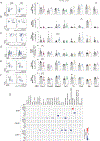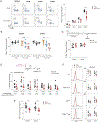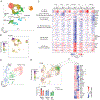A chemogenetic screen reveals that Trpv1-expressing neurons control regulatory T cells in the gut
- PMID: 39088603
- PMCID: PMC11416019
- DOI: 10.1126/science.adk1679
A chemogenetic screen reveals that Trpv1-expressing neurons control regulatory T cells in the gut
Abstract
Neuroimmune cross-talk participates in intestinal tissue homeostasis and host defense. However, the matrix of interactions between arrays of molecularly defined neuron subsets and of immunocyte lineages remains unclear. We used a chemogenetic approach to activate eight distinct neuronal subsets, assessing effects by deep immunophenotyping, microbiome profiling, and immunocyte transcriptomics in intestinal organs. Distinct immune perturbations followed neuronal activation: Nitrergic neurons regulated T helper 17 (TH17)-like cells, and cholinergic neurons regulated neutrophils. Nociceptor neurons, expressing Trpv1, elicited the broadest immunomodulation, inducing changes in innate lymphocytes, macrophages, and RORγ+ regulatory T (Treg) cells. Neuroanatomical, genetic, and pharmacological follow-up showed that Trpv1+ neurons in dorsal root ganglia decreased Treg cell numbers via the neuropeptide calcitonin gene-related peptide (CGRP). Given the role of these neurons in nociception, these data potentially link pain signaling with gut Treg cell function.
Figures







Comment in
-
Mapping gut feelings and immune control.Science. 2024 Aug 2;385(6708):496-497. doi: 10.1126/science.adq9533. Epub 2024 Aug 1. Science. 2024. PMID: 39088639
References
-
- Cryan JF, Dinan TG, Gut microbiota: Microbiota and neuroimmune signalling-Metchnikoff to microglia. Nat Rev Gastroenterol. Hepatol 12, 494–496 (2015). - PubMed
-
- Blackshaw LA, Brookes SJ, Grundy D, Schemann M, Sensory transmission in the gastrointestinal tract. Neurogastroenterol. Motil 19, 1–19 (2007). - PubMed
Publication types
MeSH terms
Substances
Grants and funding
LinkOut - more resources
Full Text Sources
Molecular Biology Databases
Research Materials

